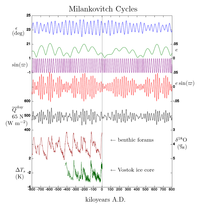
Photo from wikipedia
Atmospheric hydrological cycles over the Arctic and Antarctic have been investigated in the previous studies and there are some similarity and dissimilarity in the two polar regions. The Arctic and… Click to show full abstract
Atmospheric hydrological cycles over the Arctic and Antarctic have been investigated in the previous studies and there are some similarity and dissimilarity in the two polar regions. The Arctic and Antarctic are areas of moisture flux convergence through the year. So the precipitation (P) exceeds the evaporation (E) and the net precipitation (P-E) is positive. Therefore, the atmospheric moisture transport is a primary input of water into the polar regions. Meanwhile the climatological seasonal cycles of P-E over these regions are dominated by transient moisture flux associated with cyclone activities, the interannual variations are governed by the stationary flux associated with the Arctic Oscillation and the Antarctic Oscillation (AAO). In addition, recent climate changes influence the polar hydrological cycles. Our analyses using an atmospheric reanalysis up to recent years indicated that there were no significant long-term changes in the poleward moisture transport into both the Arctic and Antarctic during 1979-2016. On the other hand, the water vapor (precipitable water) were clearly increasing over the Arctic and gradually decreasing over the Antarctic during the same period. As expected, the increasing trend of water vapor was due to the large warming over the Arctic. There were two reasons for the gradually decreasing trend of water vapor over the Antarctic. The first one was the positive trend of AAO in summer and the second was deepening trend of the Amundsen low in autumn. The trends in water vapor and temperature during the past 38 years further suggest that both polar regions were getting dryer in several seasons. The trend, however, needs to be confirmed by follow-up climatological analyses.
Journal Title: Czech polar reports
Year Published: 2017
Link to full text (if available)
Share on Social Media: Sign Up to like & get
recommendations!